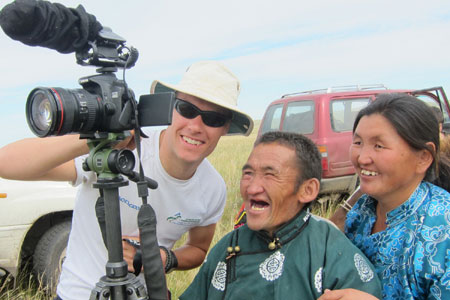Chasing vestiges of the great wall
 |
|
Cameraman David Watson shows video footage to herders on the Eastern Steppe in Mongolia. Wu Qi / for China Daily |
Looking for clues
My team drove northeast through the hills and swollen rivers of Henti province for two days before reaching the edge of the Eastern Steppe.
It was dry, sunny and cool as we followed a track pressed into deep grass. This is Mongolia's best type of road in my opinion: made by use, not made to be used.
Amid this ocean of grass I hoped to pick up the most westerly remains of the Genghis Khan Wall. I had GPS and sheets of very detailed maps on which each thumbnail showed 2 km of territory, but where was the start of the wall?
In previous expeditions - through deserts, hills and mountains - I'd scrutinize the landscape in all directions by looking for the wall's defining characteristic: linearity. Here, it was quite different. In the expanse of green, there was nothing to really focus on, little to provide any depth of field.
We eventually discovered the wall by finding its "shadows". A track, a shallow trench and a slight mound stretched side by side, across the steppe, into the horizon.
In Mongolia's wilds, which was sparsely inhabited and devoid of landmarks, early travelers created markers by piling stone upon stone. These structures grew little by little, higher and higher, as more explorers followed in their footsteps.
These Mongolian markers, called "ovoos", eventually assumed religious significance outside their practical use. This amazing structure running across the steppe, inviting people to follow it, became known as "Kherem Zam", or "Wall Road".
When I turned around, out of nowhere, about a dozen horses were making their way toward the wall. Led by a handsome gray, the majestic animals approached. They strutted across the darker grass of the trench to the crown of the mound, pausing to look, nod their heads and swish their tails.
I stood transfixed. I couldn't have expected a finer welcome at the Eastern Steppe's Wall of Genghis Khan.
My companions and I camped nearby, just a few hundred meters inside the line of the wall, beside a walled square. These, we found, had been established along the structure's entire length, and might have acted as barracks and post stations for messengers.
"Huge herd of gazelles on the right - 3 o'clock!" the radio crackled.
Using binoculars, I followed the directions. I panned forward but could not reach the front of the herd before losing the animals over the skyline. Panning back through 3 km of steppe, I saw several thousand of them galloping.
We drove on and soon crossed paths with the gazelles. Across the wall, the trench and the road, they sped right in front of us. At that moment, the animals showed us how useless a trench-mound structure would have been to stop them in their path.
At the same time, I could imagine the drama, and later the carnage wrought by Ogodei's palisade, his archers standing behind it with their bows drawn.
I'd invited biologist Kirk Olson to join the expedition because he lived in a yurt on the steppe for five years while researching gazelles.
Olson asked me about gazelle sightings I'd made in China. He also asked me how far was it possible to drive across the Inner Mongolian steppe before encountering something - a vehicle, a building and a fence.
|
|
|

















